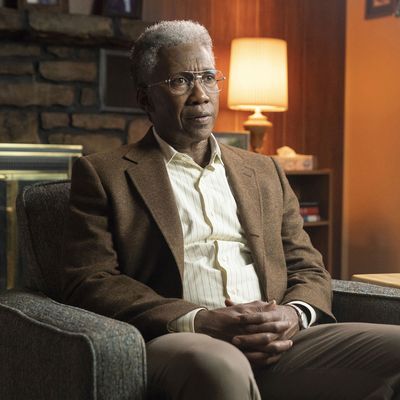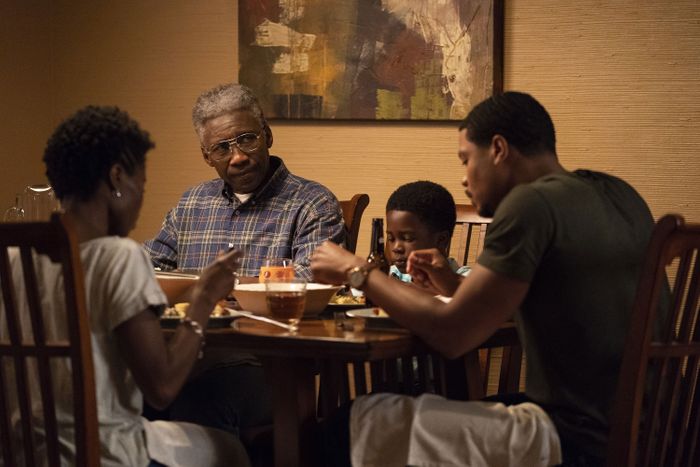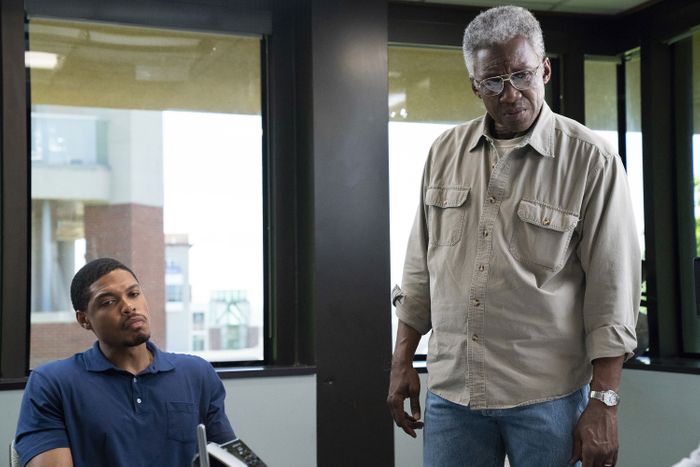
The third season of HBO’s crime drama True Detective stars Mahershala Ali, Mahershala Ali, and Mahershala Ali — as a character in his 40s, in his 50s, and in his 70s, a demanding three-part performance that leaps between glimpses of an unsolved murder case in small-town Arkansas in 1980, 1990, and 2015. As state police detective Wayne Hays, Ali is obliged to portray three distinctive shades of one complex character, a feat accomplished both by the gifted actor’s exceptional talents and by a hair and makeup department that are very clearly virtuosos in their field. In the 2015-set scenes, Ali really looks like a 70-year-old man — something of a surprise, when you consider that most actors in old-age makeup just look like young men with a bunch of junk glued on their faces.
For this we have to thank Mike Marino, self-described “makeup engineer” and owner of Prosthetic Renaissance, a design studio that specializes in practical makeup effects. Marino has done elaborate makeup and prosthetic work for Alejandro Iñárritu (Birdman), M. Night Shyamalan (After Earth), and Martin Scorsese (The Wolf of Wall Street); he created the flabby, time-weathered face John Travolta wore in the now-notorious gangster passion project Gotti, and, one would be remiss to overlook, dreamed up the unforgettable neck testicles Hugh Jackman dons opposite Kate Winslet in the omnibus comedy Movie 43. Marino is the guy you call when you want to make it look like someone’s arm has been nearly hacked off by a cabal of neo-Nazis with X-Acto knives, as he did for Green Room, or who you ring up when you want Christina Hendricks to slice off her own face, as he accomplished in Ryan Gosling’s Lost River.
And yet, despite this wide range of synthetic ingenuity, there is nothing more difficult for a makeup artist like Marino than making someone look old. “A realistic makeup is the hardest thing to do in makeup, period,” he explains. “It is the pinnacle of skill. The pinnacle of believability. I can make an alien, and I can make it have 50 eyeballs or whatever. No one knows what it looks like. But an old person? Everybody knows what an old person looks like, so therefore you can’t get away with anything that looks fake or has technical problems.” If you’ve ever guffawed at the sight of an actor with ersatz liver spots or a bunch of phony-looking bags under the eyes, you can appreciate the seriousness of the problem. “If I drop the ball, nothing works.”
On a project as ambitious as True Detective, Marino’s job begins with a conversation. He has to talk to the actors he’ll be working with to get a sense of their willingness to submit to the demands of the process, which can be unpleasantly intensive. But he says Ali and co-star Stephen Dorff were “down to do anything.” Marino had already worked with Ali once before, on the Derek Cianfrance drama The Place Beyond the Pines, and the dinners they’d enjoyed together on that production made for an easy rapport. “I met with Mahershala in Los Angeles with Stephen Dorff,” Marino remembers. “I took photographs of them, extensive photographs. I found out how they felt about these characters. Then I took a life cast of both of them, and I brought those back to my studio to start analysing them — you know, looking at every wrinkle, everything about them I felt would age.”
At this point Marino becomes a sculptor. “I sculpt in clay, I design, based on what I think they should look like,” he explains. “The heart of makeups like this are in this sculpture phase, this design phase. That’s where everything is actually built.” As inspiration, Marino looked to a makeup masterpiece: F. Murray Abraham’s aged face as Salieri in Amadeus, designed by legendary Godfather and Exorcist makeup designer Dick Smith. Smith, who died in 2014, was a friend and kind of mentor to the young Marino, and he continues to regard his makeup work as the finest examples of practical aging effects in history. In fact, Marino owns the mold Smith to make the old Salieri — he’s acquired quite a collection of famous makeup pieces over the years, including Max von Sydow’s aging pieces from The Exorcist — and he studied it thoroughly in devising the sculpture of Ali. “What I found was that most of Abraham’s face was still there and not covered up,” he says. “That’s the trick. Not covering the face entirely with prosthetics, but to integrate prosthetics into the face in a way where you cannot tell where they begin and end.”
Marino is an artist concerned expressly with how faces look. And there was an obvious respect in which how Ali’s face differed from most of the actors he was accustomed to making older: the color of his skin. “I’ve predominantly done more white actors for some reason,” Marino says. “That’s not by choice. It just happens to be that way.” It may be that the kinds of prestige projects that oblige actors to become old men tend to cast white stars. It may be that Hollywood is overwhelmingly white. In any case, there weren’t many prominent examples of black actors in convincing old-age makeup for Marino to look to for a model of how it might best be done.
So he turned to an unusual case: The Nutty Professor. “I think that’s one of the best makeups that was ever done,” he says. “What Rick Baker did — even though it was a comedy — was so successful. What I noticed and what I learned that helped me with Mahershala is the colorization of dark skin. If you look at The Nutty Professor, the way the skin is colored, and the way the skin moves, is so different from how I would approach Stephen Dorff’s makeup, which is completely different colorization, completely different wrinkle pattern, completely different texture of skin. What I learned was how to color black skin properly. There are certain oils that are different. Black skin is smoother. Textures are deeper in certain areas and textures are less in certain areas than in a Caucasian face.” Getting this right was essential to the success of the effect. “It was a real challenge,” he says.
Once the design process is complete and the sculpture has been approved by the producers, it is broken down into component pieces that can be duplicated and manufactured as individual prosthetic parts that create the effect of wrinkles and folds of older skin. These are the bits and pieces that will be applied to the actors when they arrive on set each day by the show’s team of seven-plus hair and makeup artists. You often hear of the grueling business of heavy-duty makeup application in the movies, whether it’s tales of Jim Carrey undertaking torture-endurance training to get ready for The Grinch or Doug Jones spending more time in the makeup chair than on camera in role after role. You would think adding a couple of decades to your face would be less arduous than transforming into a madcap monster, but the 70-year-old version of Detective Wayne Hays was the work of half a day. “It was basically coming to work, at first, about five hours early,” Ali recalls. “Eventually we got it down to where they could apply it in about three-and-a-half hours.”
The result was worth the effort, as was evident immediately to everyone on set. “When the director of photography actually saw the makeup tests, he came up and hugged me, and he said, Holy shit, I can’t believe we can shoot this in extreme closeup and still holds up. It was a real honor that he said that, but it’s really a testament to practical effects,” Marino says. Increasingly, it seems, Hollywood is rejecting traditional effects work like these sorts of prosthetics and makeup in favor of the digital, whose easy wizardry is responsible for the recent craze for the uncanny “de-aging” seen in Westworld, Rogue One, and Captain Marvel — even, reportedly, Scorsese’s upcoming Netflix film The Irishman. Marino is aware that he can’t make someone look young again the way a computer can, but he is adamant that, when it comes to making a 40-something man look 70, what he does can’t be beat. “I hope that filmmakers begin to trust practical makeup effects more so now after seeing work like True Detective.”



